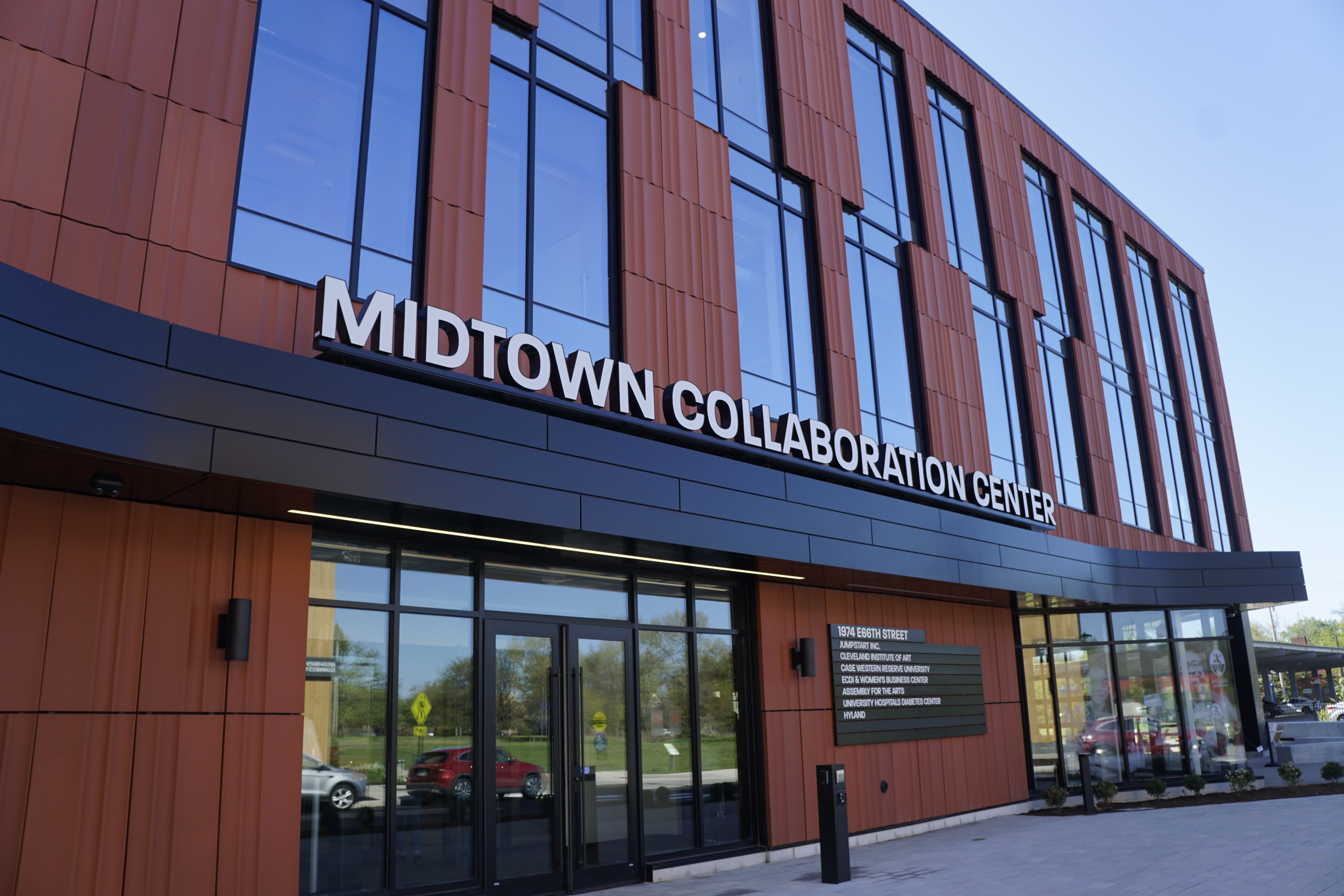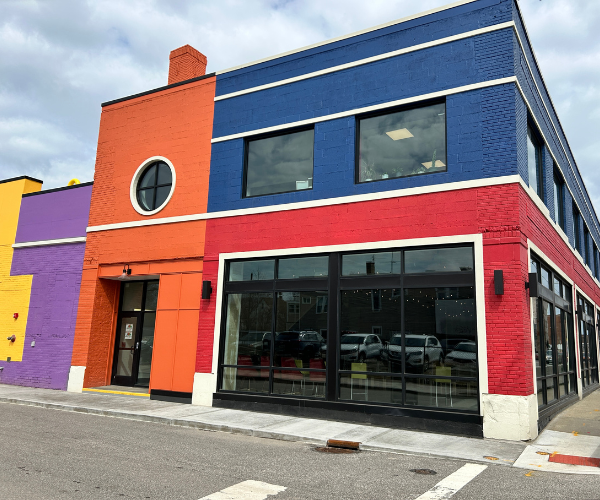Under the Gun
As potential development and rural culture collide, Eaton Township is in the crosshairs of a controversy that threatens its identity.
by James Bigley II | Oct. 16, 2017 | 12:00 PM

PHOTOGRAPHED BY KEVIN KOPANSKI
Donna Hicks and her husband slowly make their way across the yard.
I have only been sitting with Roseanna Edwards and her 20-year-old son, Anthony, in their Eaton Township garage for a few minutes. But the neighbors noticed, the way a hound strikes a scent.
The Hickses have lived in Eaton Township for 40 years, the last 20 on Dye Road. They remember when their ranch was just one of a few down the street from Carpenter-family land.
There’s been an uptick in bees near the edge of the property because of a nearby hive, Donna says.
Mention of it causes Anthony to perk up in his chair.
“A hive about that size takes in 40 gallons [of water] a day,” he says. “You’ve got to figure, if they’re making that much honey, it’s got to come from somewhere.”
Donna’s husband, distracted, lifts the bill of his ball cap just enough to peer around the corner to the back of the Edwardses’ property. He points out two small bucks making their way through a nearby field.
“That’s what we love about living in a township,” says Roseanna. “We talk about bees and deer.”
“It’s all right as long as you don’t hear ‘bang, bang,’ ” Donna’s husband says, mimicking a cocked gun with his left hand.
It’s a sentiment felt strongly among many of the neighbors on this particular stretch of road. In 2014, Roseanna discovered two bullet holes on the east side of her unattached garage. In November, another neighbor’s pool collapsed when a .50-caliber bullet punctured its wall. And in January, Roseanna’s husband, Thomas, came under fire.
He was standing near the kitchen island just after 5 p.m. on a Monday when the first bullet shattered the south-facing window in the living room and passed within 10 feet of where he was standing. It tore through the opposite wall, traveled across the hallway that led to their bedroom, punctured the bathroom door and lodged in the northern wall of his home.
A second bullet passed within 3 feet of Thomas and nearly hit their small Yorkie poodle, Sophie, sitting on the back of an armchair, before it came to a dead stop in the front-door frame.
When a third bullet ricocheted off the drywall above the front door and landed on the kitchen tile, Thomas grabbed his coat from the closet, ran outside, afraid for his life, and called the Lorain County Sheriff’s Office.
Intent on finding the source of the gunfire, he jumped in his truck and drove a mile south to Cooley Road where he discovered two men in their 20s. As best he could tell, they weren’t from Eaton and looked like they were about to skedaddle.
The Middleburg Heights and Strongsville residents had brought a Sig Sauer pistol, a Kel-Tec 12-gauge shotgun and a Marlin .22-caliber rifle out to the 23-year-old’s grandfather’s house for some target practice on a few pieces of lumber stacked 3-feet high and 2-feet wide near the back of the property, according to police reports.
While it’s illegal to shoot a gun within the city limits of Middleburg Heights or Strongsville, it’s just fine in Eaton Township — or any township in Ohio for that matter. According to the Ohio Revised Code, firing a gun on private property within a township is completely legal as long as a bullet doesn’t cross a road or knowingly enters into a home, school or cemetery. In fact, townships can’t even regulate the types of guns someone fires while on private property.
Further investigation by a sheriff’s deputy revealed the two men also had a Sharps .556-caliber rifle designed to hunt large game at long range.
They denied shooting the Sharps rifle. However, police reported it was warm to the touch, smelled like burnt gunpowder and matched the bullets that traveled 2,192 feet through a 100-foot tree line, across a field of soybeans and into the Edwardses’ home.
The two men have since been charged with tampering with evidence, falsification and criminal damaging or endangerment, but they cannot be held criminally accountable for the damages done to the home unless it’s proven they did it intentionally.
“There’s no such thing as a stray bullet,” Roseanna says from behind a plastic table in her garage. “There’s somebody who fired that bullet, and they should know and be responsible to know their target.”

In many ways, Eaton Township is in the crosshairs. Founded in 1810 as part of what is now North Ridgeville by settlers heading west from Connecticut, it is divided into nifty quadrants by state routes 82 and 83 in eastern Lorain County.
In these rural 23.4-square-miles, guns are as much a part of life as the soil, the soybeans or the bees. For generations, they’ve been used to protect residents’ animals, their families and their land. But as the suburbs are expanding, Eaton Township seems to be staring down the barrel of a development boom that threatens its way of life.
After the incident in January, Roseanna, Donna and another resident, Elizabeth Rattray, set their sights on reform. They pressured township trustees to advocate for a change in state law that would allow townships to determine their own gun regulations much like municipalities.
According to data compiled by Cleveland Magazine from the Lorain County Sheriff’s Office, the department has received an average of two calls for shootings and 20 calls for shots fired within Eaton Township every year for the last seven years.
Although the numbers are not striking, residents are ringing the alarm.
In March, state Rep. Dick Stein responded by organizing a town hall to hear from Columbia and Eaton township residents on the issue. About 100 people, including state Sen. Gayle Manning, showed up to the meeting in Columbia Township — many to oppose changing the regulations on guns and voice their concern about their Second Amendment rights.
“People shouldn’t come out here and not expect gunfire,” Elizabeth recalls people saying at the meeting.
Elizabeth, who has also joined the group in the Edwardses’ garage, crosses her arms and sits back in a chair.
She’s a mother, an insurance broker and a member of the National Rifle Association. When she first moved into her home in 2007, she shot target practice with a neighbor in their backyard until she realized, This isn’t safe anymore.
So now she and her husband go on date nights to the Select Fire Training Center in Berea and practice at a range.
“OK, I expect [gunfire],” Elizabeth continues, “but I don’t expect to die in my house when I’m not at war.”
At the meeting with the state legislators, she shared a parable. When Henry Ford developed the automobile for the masses, he never worried about traffic signals, street signs or seat belts. He just built the damn thing in the name of progress and society adapted accordingly.
“I like my car, and I like my guns,” she said. “I need to use it responsibly and have some sort of parameter that keeps me from running over my neighbors’ cats and kids and shooting them.”
Times have changed, and Elizabeth believes someone in government needs to put up a stop sign. Henry Ford’s Model T topped out at 40 to 45 mph. Bullets from the Winchester Model 94 rifle John Wayne used in The Man Who Shot Liberty Valance only traveled about 75 yards.
And in Eaton, where generations of farmers once cultivated crops, it’s more profitable for developers to plant houses.
By the end of the March meeting, it was clear: a township can do very little about this issue.
For the last 10 years, the Ohio Township Association has been advocating for a change in law that provides discretionary measures for townships with higher population density. But getting someone to introduce a bill to change the way townships operate has been nigh impossible. To many, a change in state law means a change in the U.S. Constitution.
So faced with limited legislative powers and new housing development on the horizon, Eaton Township is being squeezed into a corner of the barn. It may be forced to give up its rural identity and become a full-fledged city or watch as bits of Eaton are plucked like chicken feathers by surrounding communities.
“We’re in a unique place where we’re redefining ourselves,” says Elizabeth. “That is really causing a challenge because there’s old versus new, city folk who became country folk — it’s a mix now.”

They don't take too kindly to outsiders.
When Pat Ables, gray-haired and bespectacled, turns off Island Road into Eaton Estates, a winding labyrinth of 470 squat two- and three-bedroom prefabricated houses, she shakes her head.
When soldiers returned home from World War II and started migrating from surrounding cities in search of housing, this development of National Homes was erected almost overnight to meet the influx of growth in the township. Over the years, some have added garages and small additions, further coagulating the spaces between buildings.
“They were not meant to be permanent,” she says. “But they’ve turned into that.”
More than 60 years later, many of the township’s residents refer to the 1,032 people who live here as outsiders — those people. Although they make up 17 percent of the township’s population, many blame them for forcing Eaton’s schools to consolidate with Grafton, Belden and Carlisle to create the Midview School District in order to meet the demands of sudden growth.
“I know there has to be growth whether I want it or not,” says Pat.
As we drive through the neighborhood in her green minivan, she passes homes in various states — some with pools, others with paint-chipped exteriors and overflowing trash cans beside rows of cars that look more like rusted hulks of machinery.
Pat remembers the name of the farmer responsible for selling the land so this development could be built, but she won’t say it. He still has family living in the community — and here in the country, you don’t speak ill of the dead.
“Some things you have to do, but you have to do it kicking and screaming,” Pat says.
Eaton Township has been fighting to protect its identity almost since the start. Although the United States Post Office Department was founded in 1792, there’s no record of a township postmaster until 41 years later.
For nearly a century, the position was filled by political appointment and operated out of homes, feed stores and groceries with an ever-rotating list of names. But in 1928, the post office was abandoned, forcing mail to be sent through surrounding cities and erasing Eaton Township as an official address.
The township has continued to evolve — not necessarily on it’s own — with the ebb and flow of surrounding cities. What was once a perfect square on the map, Eaton Township is now a slightly lopsided collection of wetlands, light industry and agriculture, chipped away at the northwest and southern edges by annexation.
In 1987, the village of Grafton grabbed 1,678 acres from the south, taking the Grafton State Prison Farm and the future sites of the Grafton Correctional Institution and Lorain Correctional Institution. A lawyer representing the township referred to the annexation in a Plain Dealer article as a minnow swallowing a whale, because the village of Grafton was only half the size of the territory it was annexing.
Townships by law cannot impose an income tax. But villages can. In annexing the prison property, the village of Grafton won $110,000 to $120,000 in annual income tax revenue. It also created a rivalry with Eaton residents and an aversion to Grafton’s shops.
From 2000 to 2005, there were four more annexations in Eaton Township resulting in the loss of 120 acres to Grafton and Elyria. In the last year, North Ridgeville has annexed 130 acres, pushing its northern boundary farther south. And in April, Grafton gained permission from Lorain County Commissioners to annex a strip of land leading up to Midview Schools campus in Eaton — what some argue is a sign that Grafton will one day swallow the school system in yet another attempt to diminish the township’s identity.
“It’s kind of like in the old days when they were moving west,” says Pat. “I’m sure the Indians weren’t real happy when we came storming through.”
She points out the S-curves in the road that delineate today’s boundaries for North Ridgeville to the north, Grafton to the south, Carlisle Township to the west and Columbia Township to the east. Many of the roads she navigates — Durkee, Crowley, Reed and Hawke — are all named after early settlers whose families owned and lived off the farmland within the township. In fact, Hawke Road is said to have once been the driveway to the Hawke family farmstead that belonged to Pat’s ancestors generations ago.
“It’s a hard life,” she says. “You’re not going to get rich. It has to be something in your heart, that you really love the land and you love being out there working in the land and the solitude of it.”
As Pat passes Schild’s IGA Marketplace, a family-owned and operated grocery store, she slows to point out her former two-story home, which once sheltered both her great grandparents and grandfather. The house’s peeling yellow paint is hardly noticeable behind the overgrown trees. An old grindstone is displayed proudly in the front yard.
At one time, she and her first husband owned the property next door where Aquarian Roofing is now and farmed soybeans, sweet corn and wheat on her father’s land just down the road.
They would have been content living there, except a bar that jutted up against their property hosted turkey shoots on Sunday afternoons.
“It drove my husband crazy,” she says. “The kids couldn’t even go out and play in their own yard.”
So they moved to a 3 1/2-acre lot on Cooley Road, where she’s lived for 45 years. She doesn’t want to talk about guns the same way she wouldn’t talk about the farmer who sold out for Eaton Estates, because it’s not like it once was. When she was growing up, her father had a gun to protect their animals from predators, to keep their family safe. Now, there’s little need for protection.
“I’ll show you my farm,” she explains. “Let it speak for itself.”
It’s the last house in a row of eight, piled so closely together it’s hard to tell whose property belongs to whom unless they’ve put up a fence. In her backyard, she’s got a wooden swingset she built for her grandchildren beside a small pond.
There’s a large limestone block in the crook of three trees in the front yard, the last remnants of the farm’s original barn that once held more than 2,000 bales of hay. Now, there’s only one old red barn that holds a few chickens, three fat ducks, a goat and a sheep whose wool is so thick it looks like a moving bale of hay.
Before her kids grew up and her divorce in the ‘80s, the farm was self-sustaining. They raised Holstein cows and butchered them for meat. She canned pickles, tomatoes and green beans, storing up hundreds of jars at a time. Now, she’s a retired first-grade teacher who farms as a hobby.
“I think real rural people have a greater respect for everything and life in general,” she says. “Idle hands are the devil’s workshop, that’s all there is to it.”

Brian Lanckiewicz straddles the line between new and old. As the owner of Columbia Fence in Eaton Township, he’s been creating white-picket dreams for 8 1/2 years.
He’s also a good neighbor, the kind who calls the sheriff’s office and locals living nearby to notify them before he shoots his guns.
His 6 1/2-acre property in Columbia Township is a merging of worlds in which his 13 German shepherds can roam freely around a half-wooded lot. There are overlooks and a gazebo, and a large gravel pit he’s dug to keep bullets from flying out of the property.
As he stands in the heart of it, Brian squares his shoulders, plants his feet in the dirt and leans against a plywood table. He grips both handles of an MG74 — a fully automatic machine-gun used by the Austrian Army. It’s capable of firing 850 heavy bolts per minute.
When he holds down the trigger, bullet after bullet rips in quick succession over 100 yards in front of him exploding 2-liter Faygo bottles, puncturing metal barrels and pinging off a swinging steel target erected in front of a 20-by-100-foot backstop made from a mountain of dirt, leftover fencing and debris.
By the time the last casing clinks on the ground, Brian has shot 50 rounds in eight seconds.
“You come out here, and you shoot some rounds off,” he says. “You feel like a new person afterward.”
Brian and his fiancee have been living in a home in Berea that butts up against the Ohio Turnpike for three years. They purchased the property here with the intention of building a house and a private gun range three years ago.
Since then, he’s installed three small fishing ponds and has hosted private shooting demonstrations for veterans and local police departments.
“They’re the kind of people I like,” he says. “Family people. People who’ve fought in the military. People who are making this world safe.”
He turns and points to a small arsenal of semi-automatic machine-guns, rifles and pistols on plywood tables — only a portion of his inventory of more than 200 guns he owns and sells as a private dealer.
As he walks through what he has on hand, he’s quick to point out their importance. He’s got a Heckler & Koch P30L pistol — the same gun Keanu Reeves used in the film John Wick — beside a World War II Thompson submachine gun and three H&K G28 rifles the U.S. Army adopted in April.
When he picks up a black-and-brown flecked H&K 416 rifle, he smiles.
“This is the gun SEALs used when they killed Osama bin Laden,” he says. “A couple of [police] departments have tested this and love it, and we’re getting them for their SWAT units.”
For Brian, grandson of a World War II veteran, collecting guns is a hobby similar to collecting cars.
Earlier this year, residents unsuccessfully pushed back against having the private range in the township, but he isn’t breaking any laws. In fact, his backstop meets National Rifle Association standards and runs right across from a set of railroad tracks — not residences — on which a train comes roaring through every hour.
The fence maker has an all-American vision built on hard work and recreation. “Eventually, I want to get a rental business going,” he says. “Fathers will bring their sons out. Bachelor parties. Whatever. People can come out here and have fun.”
He shared this ideal at Columbia Township’s meeting in March, where other newcomers joined him in opposition.
Tony Manning moved to Columbia Township in February after living in Avon for 16 years. It had grown too big, too fast, and he felt there was no vestige of land left for him to conquer.
“These people don’t do their homework,” says Tony. “It’s like you move and you’re on a railroad track and you can’t believe the train is going by.”
As a freelance high-risk management consultant, Tony says you can’t take the noise away from the train. “Every law that’s passed takes a piece of your freedom away,” he says.
When Brian looks across the street, beyond the black chain-link fence he built around his property now, he envisions having freedom on a much larger lot. He’s got a deal in the works to purchase 24 acres of farmland kitty-corner to where he is now.
“This is like our peaceful place,” he says. “We’re going to build a bigger version of it.”
The days of trapshooting on the farmstead and putting ol’ Bessie down behind the barn has long since past.
Now, things are much quieter on Pat’s farm. Occasionally, her grandkids set up targets in the bank of the pond and practice with shotguns before competing in local shooting competitions. But they’re diligent, careful not to disturb the land.
“They’ve learned a respect for the land, for animals, for people,” she says. “It’s a
different kind of mischief out here.”
She harkens back 40 years when kids would tip over outhouses, layer windows with soap and leave flaming bags of poop on porches — a time when mischief was defined by uninhibited exploration and curiosity.
When her kids were bored, she’d set them to work or send them trekking south across the fields and through dense woods to spend the day with her mother on the other side of the train tracks near the intersection of Hawke Road and state Route 82. They’d be gone all day and come home before sunset.
“I’m about 2 miles from home,” she says, misty-eyed, “but maybe about a mile as the crow flies.”
As Pat stands near the edge of her property, her corgi, Millie, sniffs her way along the bank by the road and past a dead tree gnarled and pocked with woodpecker holes. Beyond that, there’s a 40-acre field of soybeans with a huge thriving tree in the center of it — the last of a long-gone hedgerow.
“This is peace,” she says. “This is the way God intended it to be.”
She explains that someone bought the farm next door 40-some years ago speculating it’s going to someday be worth enough to sell to a developer. She then turns and points to an old white house across the street.
“The old farmer who lived over there said to me one day when this was all rural, ‘I know someday Cleveland is going to encroach, and you’ll see houses and houses from Cleveland clear out to wherever.’ ”
She pauses and tugs the front of her thin brown cardigan close.
“We could see it happening,” she says. “When you have so many people and they need places to go, here’s land now.”
When she envisions the future, she sees parking lots and traffic, streetlights blocking out the stars. She imagines kids with a familiar curiosity and need for exploration trampling through the back brush of her farm, breaking into her barn and stealing firewood from the side of the house.
“There’s a different attitude when you’re more citified and you have more amenities,” she says. “Maybe it’s people living on just the house and the lot, and they don’t have the responsibility of taking care of a large area and a lot of animals.”
As a member of Eaton’s zoning board, she frequently hears complaints from new residents who move into township areas where no cable or internet lines are installed, where there’s a lack of connection.
For Pat, who attends and volunteers at the North Eaton Christian Church and attends herb guild meetings in Westlake, those aren’t the connections she’ll miss when Cleveland finally arrives.
“The tranquility will be gone,” she says.

When Donna Hicks approached Matthew DeTemple, executive director of the Ohio Township Association, at a July Lorain County Township Association meeting, she wanted to know how they could move forward on the guns issue.
DeTemple had a suggestion: Win over your state senator. Gathering a raft of signatures might do that.
“What’s that tell you?” says Donna, back in the Edwardses’ garage.
Elizabeth cuts in.
“I’ll be honest with you — look at me,” she says, gesturing to her black skin. “Do you think I feel comfortable knocking on doors around here? Hell no. Why do you think I own guns? I’m not safe in my own country, let alone going up against something like that.”
So at the same July meeting, when trustees opened the floor to public comment, Elizabeth stood up and asked the question again: What on earth do we do about guns?
“As soon as I asked the question, somebody made a motion to adjourn,” she says. “Nobody is thinking about this. Nobody wants to talk about this. Nobody cares. People are going to die.”
Elizabeth pauses, takes a breath with a shake of her head. “It’s about being safe in our homes,” she says. “We the people.”
And people are the problem. “Everyone wants to kind of enjoy it, but they don’t want to realize that when you start to gather, we affect each other and touch each other’s lives in ways we didn’t before,” she says.
In 2000, according to Lorain County’s Comprehensive Land Use Plan, the county’s population was expected to increase 14 percent to 321,900 by 2020. To meet the migration of 40,000 people, the county projected 31,000 new homes needed to be built.
In preparation, the 20-year-plan earmarked four of the 18 townships in the county to contain 50 percent of the new residential growth, with Eaton and Columbia townships taking the brunt of the development.
“It used to be farms all around,” says Donna. “No development, but it’s coming.”
It nearly came once before. In 2000, the Carpenter family farm switched hands. When Alan Carpenter died after a long struggle with brain cancer, his brother, Roger Carpenter, took over.
As one of the founding farmer families, the Carpenters had become one of the most revered families in the township. They owned, operated and lived off nearly 400 acres — the largest farm in Eaton Township.
Roughly one-third of the township’s land was being used for agriculture, but county officials had it pegged as developable land. Forest City Inc., the Cleveland-based real estate developer famous for owning the iconic Terminal Tower, saw it as an opportunity.
By 2006, a Forest City subsidiary, Sunrise Development Co., had a plan to build more than 500 units on 267 acres alongside a recreation center on the Carpenter family’s former farm.
In order to meet the demands of such a massive development, township regulations required the developers install and provide water service and a wastewater system.
The proposal, it turns out, paved the way to start a large sewer project run by the Lorain County Rural Wastewater District.
Sunrise Development agreed to hold off on development for two years so the sewers could be installed. If it wasn’t finished within that period, Sunrise could then connect to wastewater treatment centers in the city of Elyria and the village of Grafton.
“As they expand the growth, they also have to expand the services they provide,” says Lorain County commissioner Ted Kalo.
The economic housing crisis of 2007 and 2008, however, forced Sunrise to abandon its plans, even as sewers were being installed.
“When they pulled out, we heaved a big sigh of relief because we were not ready,” says Elizabeth, who sat on Eaton’s land use committee in 2010.
“We thought, If developers are looking here, how do we have any say in what can or can’t happen?” she says.
While the projected growth from that 2000 plan never materialized, Pat says, damage has already been done. The failed Forest City project pushed many current and future residents into an unwanted sewer district.
“There was an assumption that 400-plus houses would pay for that project,” says Pat. “That didn’t happen, so now everybody else who has it has to pay the higher cost for the sewers that we really didn’t want or need to accommodate someone’s pipe dream of putting in beaucoup houses over there.”
———
If you head south from Eaton Town Hall on Avon Belden Road, you’ll see the signs. Farmland for sale — 19 acres, 30 acres, 34 acres — all along the road for miles.
And if you head north past state Route 10 and make a right onto Chestnut Ridge Road before you hit North Ridgeville and Elyria, you’ll find 84-year-old Melvin Ternes sitting in a lawn chair bent forward, sharpening a metal lawn mower blade clamped to the back of a small John Deere wagon in his garage.
The skin of his hands has hardened like knotted leather. He’s been tending to the fields of his family’s farm since 1951. Except for a two-year stint as a bridge builder at the tail end of the Korean conflict, Ternes has lived on this farm for all of his 84 years.
Of course the farm doesn’t look like it once did. In its heyday, the house he’s living in sat on 130 acres he owned. He leased close to 500 acres more from various farmers in the township to make an honest living. But when he became ill in 2002, he pulled back, selling all but 15 acres to a developer.
“At that time, it was not that hard of a decision to make,” he says with grit in his voice and a Southern drawl. “There’s times since then I wish I had it back.”
He deadpans and readjusts his red International Harvester cap.
In the backyard, the dividing line is striking. Eaton Township stops where Ternes’ sweet corn and soybean crops end. Then, past a 100-foot wide patch of grass, North Ridgeville begins with miles of square-cut homes with gray roofs sown in neat rows so that not one house looks different than another. If you could fly high enough and look closely, you can almost count them — 599 in all — part of a senior living community called Pioneer Ridge.
“The townships are being gobbled up by housing developments,” says Ternes, taking a napkin and dabbing sweat from his furrowed brow. “What can you do when farmland sells for maybe $3,000 an acre? Development pays $10,000 to $20,000 an acre. You can’t beat it. You can’t compete with it.”
He points out the patch of land between his crops and the field of houses. It was annexed by Elyria for further development. In fact, everything south of his property all the way to state Route 83 falls inside Elyria’s facility planning area. Already, the city is encroaching on the country, albeit underground, by holding power over future developments with its sewer systems.
In December, Elyria essentially blocked an Eaton Township development project in a dispute over which wastewater utility — Elyria or the Lorain County Rural Wastewater District — would provide the service.
But for now, there’s more immediate problems on the horizon for Ternes. Marestail, a Roundup-resistant weed that chokes out crops, has spread like wildfire through their fields, and Ternes has blades to sharpen. Everything else — the choking annexation, the influx of city folk, and the loss of land — is outside of his control.
“I like to get my mowers and all that ready before next year so when spring comes I don’t have to hurry up and get everything done,” he says, as he turns back to his small green tractor. “It won’t be a whole lot, but I’ll have it ready to go.”
For more updates about Cleveland, sign up for our Cleveland Magazine Daily newsletter, delivered to your inbox six times a week.
Cleveland Magazine is also available in print, publishing 12 times a year with immersive features, helpful guides and beautiful photography and design.
Trending
-
1
-
2
-
3
-
4
-
5










